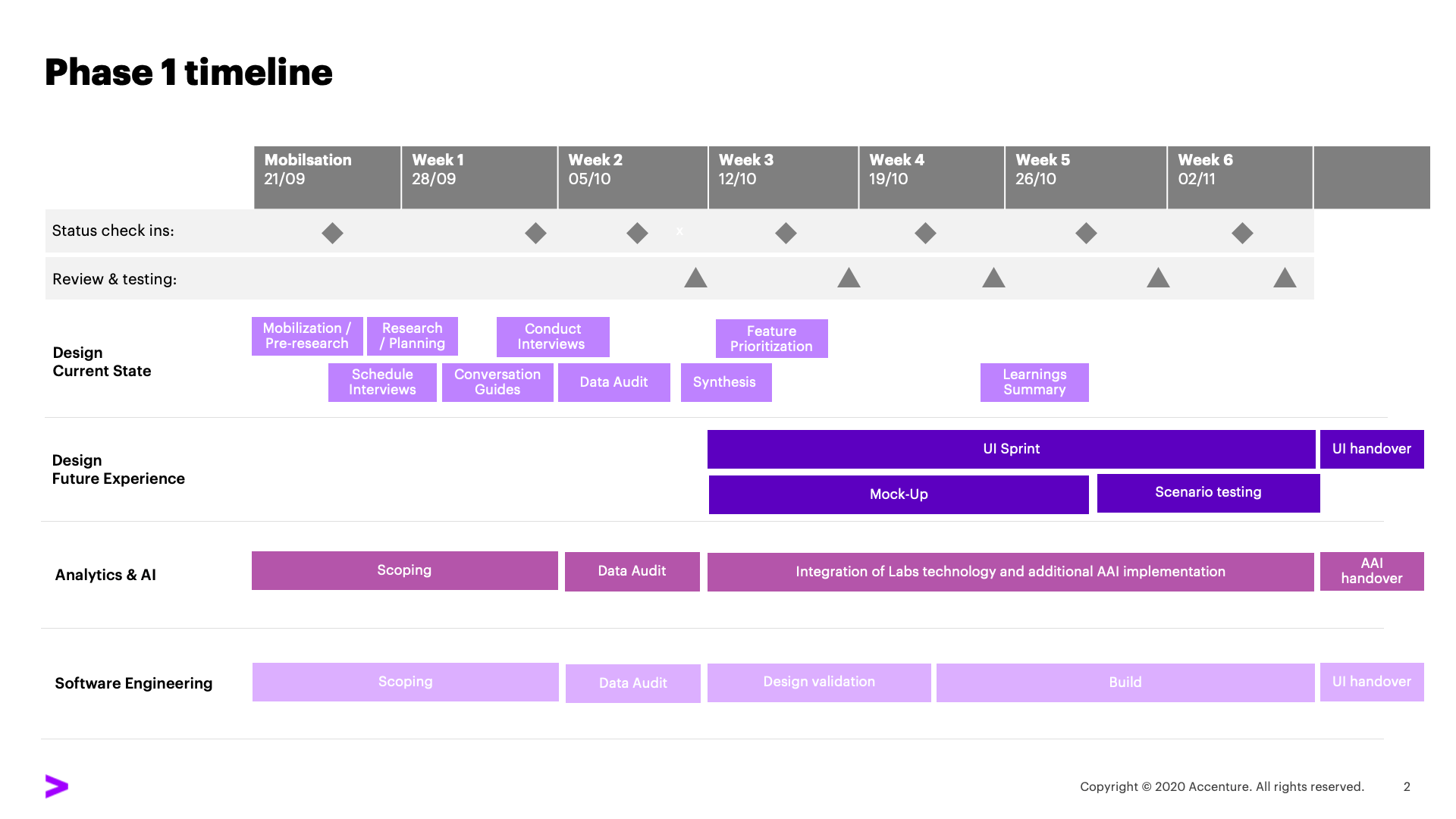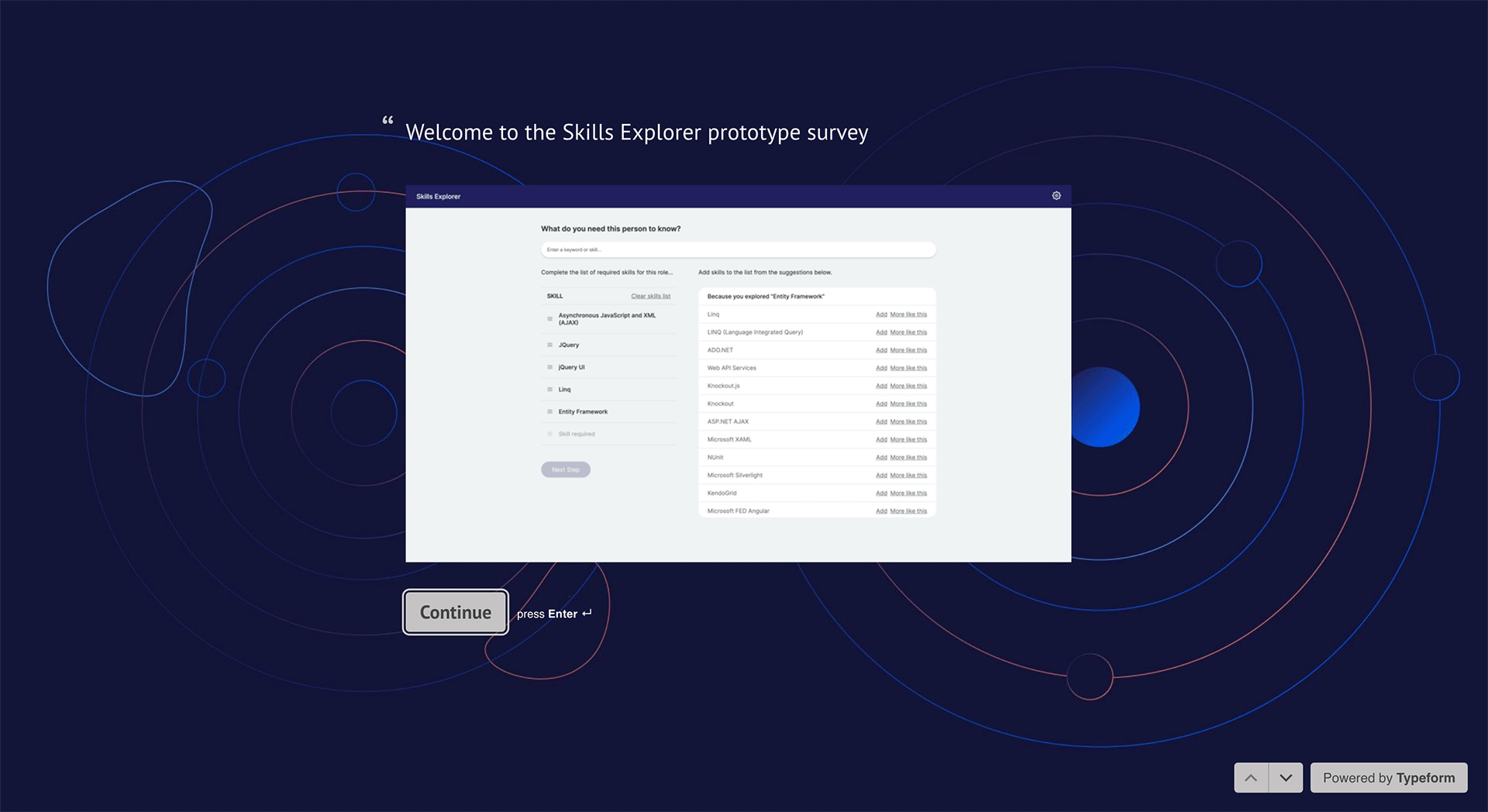Skills are an important commodity in any organisation. Employees define their skills in their online profiles both internally and on public platforms, project leads assign skills to roles and talent managers use skills data to match roles to candidates.
How might we use AI and UX design to improve the efficiency and accuracy of the skills identification and selection process and ultimately create value for HR, project leads and employees?

To help employees make better choices when exploring and selecting skill relationships to bring value in the areas of project resourcing and talent supply with assistance of AI and best practice UX design.
I led across 3 internal teams involving Rapid Innovation, Accenture Labs and AI Studio. This was a cross discipline project and a key task in this project was to communicate to stakeholders the value in human-centered design. We utilised the design thinking process to make complex AI technology simple to understand and useful to end users.

As we conducted primary and secondary research we gained an understanding of the current state workflow and wider systemic opportunities. From the system view we identified 4 main areas in which skills will make an impact within an organisation including scheduling, profiling, resourcing and balancing. We then narrowed in on scheduling as a use case for phase 1 and balancing as a use case for phase 2.
Primary research methodologies included user interviews and workshops. Secondary research was employed through previous project that explored the skills research space. Process mapping, feature prioritisation and regular usability and concept check ins allowed for continuous research throughout project phases.

We prioritised and short listed features. Below are 3 feature we concepted, designed, iterated and prototyped.
Our concepts are powered by ‘AmpliGraph’, a suite of neural machine learning models created and open-sourced by Accenture Labs. A “knowledge graph” represents known relationships between items. AmpliGraph learns how best to layout those items in an abstract space, influenced by all the links between all the items. This is useful to predict implied relationships between the items or simply to examine what skills may belong in similar contexts.
A feature we named ‘Intelligent Search’ was concepted to bring the related search that harnessed machine learning on knowledge graphs to the forefront of the user journey.
Smart filters were included so help better classify areas of skills based on the fuzzy search results. We experimented with two different techniques: ‘term frequency’ and ‘phrase mining’. These techniques were A/B tested with users to get feedback and gain insights.
This feature is an assistant to the user and suggests related and adjacent skills so that they can define skills for a job role. The user selects a starting point and our Ampligraph technology suggests nearest neighbour knowledge graph recommendations based on the search term.

This visualisation an interactive and graphic representation of the difference between the two search features in our prototype. It represent results from the ‘fuzzy’ search, which displays search results based on keyword search, which uses approximate string matching to give associated results.
It also visualises the ’related’ or ‘intelligent’ search results, using knowledge graph embeddings developed with Ampligraph. The visualisation helps users and stakeholders understand the differences between the methodologies.
Usability and scenario testing was carried out with 15 Accenture SMEs in different locations including Ireland, Poland, South Africa, India and United States. We tested with participants across the areas of Talent Supply, Fulfilment, Supply & Demand Balancing, Project Management and Business Development. Feedback was positive with users in agreement that the prototype significantly improves data accuracy, user experience and efficiency.
Interaction tracking was integrated with the software build, allowing for interactive data journeys to be analysed and tracked.
“The filters made it easier to find a skill.”- 94% end users agreed
“The intelligent search results made sense to my search term.”- 92% end users agreed
“The Skills Assistant feature was helpful.” – 94% end users agreed
“In terms of tools to help populate skills lists, I would prefer Skills Explorer to the existing tool available to me. -100% end users agreed
“Love the prototype, would not make any change if it means it can be available in production tomorrow.” Talent Supply Director, Accenture, New York, NY.

As a result of our experimentation and prototyping the project was awarded 350k in funding for an industrialised build. The new features are currently being implemented in new phases of work in the Accenture scaling platform.